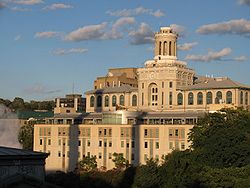
Arthur Hamerschlag
Encyclopedia

United States
The United States of America is a federal constitutional republic comprising fifty states and a federal district...
electrical and mechanical engineer who served as the first President
Academic administration
An academic administration is a branch of university or college employees responsible for the maintenance and supervision of the institution and separate from the faculty or academics, although some personnel may have joint responsibilities...
of Carnegie Mellon University
Carnegie Mellon University
Carnegie Mellon University is a private research university in Pittsburgh, Pennsylvania, United States....
in Pittsburgh
Pittsburgh, Pennsylvania
Pittsburgh is the second-largest city in the US Commonwealth of Pennsylvania and the county seat of Allegheny County. Regionally, it anchors the largest urban area of Appalachia and the Ohio River Valley, and nationally, it is the 22nd-largest urban area in the United States...
, Pennsylvania
Pennsylvania
The Commonwealth of Pennsylvania is a U.S. state that is located in the Northeastern and Mid-Atlantic regions of the United States. The state borders Delaware and Maryland to the south, West Virginia to the southwest, Ohio to the west, New York and Ontario, Canada, to the north, and New Jersey to...
, United States
United States
The United States of America is a federal constitutional republic comprising fifty states and a federal district...
.
Early life
He was born in New York, New York to Jewish immigrants from AustriaAustria
Austria , officially the Republic of Austria , is a landlocked country of roughly 8.4 million people in Central Europe. It is bordered by the Czech Republic and Germany to the north, Slovakia and Hungary to the east, Slovenia and Italy to the south, and Switzerland and Liechtenstein to the...
. (He and his mother later converted to the Episcopal Church). He graduated from the Hebrew Technical Institute in 1889 with a specialization in electricity, and did field work working on electric plants in Cuba
Cuba
The Republic of Cuba is an island nation in the Caribbean. The nation of Cuba consists of the main island of Cuba, the Isla de la Juventud, and several archipelagos. Havana is the largest city in Cuba and the country's capital. Santiago de Cuba is the second largest city...
, Mexico
Mexico
The United Mexican States , commonly known as Mexico , is a federal constitutional republic in North America. It is bordered on the north by the United States; on the south and west by the Pacific Ocean; on the southeast by Guatemala, Belize, and the Caribbean Sea; and on the east by the Gulf of...
, and throughout the U.S. Back in New York City he worked for both St. George's Trade School and the New York Trade School. His reputation there brought him to the attention of Andrew Carnegie
Andrew Carnegie
Andrew Carnegie was a Scottish-American industrialist, businessman, and entrepreneur who led the enormous expansion of the American steel industry in the late 19th century...
, who was looking for leadership for his new educational venture in Pittsburgh.
Carnegie Tech years
Carnegie and William H. Frew, chairman of the Board of Trustees of The Carnegie InstituteCarnegie Museums of Pittsburgh
Carnegie Museums of Pittsburgh are four museums that are operated by the Carnegie Institute headquartered in the Oakland neighborhood of Pittsburgh, Pennsylvania...
and Carnegie's lawyer in Pittsburgh, hired Hamerschlag in 1903 as the first director of the fledgling Carnegie Technical Schools, as the project was first called. Its aim was not to compete with the nearby University of Pittsburgh
University of Pittsburgh
The University of Pittsburgh, commonly referred to as Pitt, is a state-related research university located in Pittsburgh, Pennsylvania, United States. Founded as Pittsburgh Academy in 1787 on what was then the American frontier, Pitt is one of the oldest continuously chartered institutions of...
, but to provide practical vocational training in the industrial trades and to offer 3-year diplomas, not bachelor's degrees. And so the building of the campus began, and the hiring of faculty, and the school was launched.
Hamerschlag built the campus in partnership with Carnegie himself and the architect Henry Hornbostel
Henry Hornbostel
Henry Hornbostel was an American architect.He designed more than 225 buildings, bridges, and monuments in the United States; currently 22 are listed on the National Register of Historic Places....
. While the campus grew, the school found it difficult to compete. Industrial unions had their own apprenticeship programs, and it was challenging to attract and retain faculty, most of whom preferred to work for degree-granting institutions. So in 1912, the Carnegie Technical Schools were renamed Carnegie Institute of Technology. Hamerschlag then led the development of bachelor's and master's degree programs, and the college took off.
When Andrew Carnegie died in 1919, the funding of the college, which had come from Carnegie himself, came under scrutiny by the estate, now controlled by the Carnegie Corporation of New York
Carnegie Corporation of New York
Carnegie Corporation of New York, which was established by Andrew Carnegie in 1911 "to promote the advancement and diffusion of knowledge and understanding," is one of the oldest, largest and most influential of American foundations...
. It commissioned a survey in 1921 and the report recommended that the college broaden its sources of funds for the future. Hamerschlag, who did not have a seat on the board, felt excluded from the decision and the new direction being charted. He resigned in 1922.
He returned to New York and reestablished an engineering practice. Hamerschlag died in 1927.
Hamerschlag Hall, the home of the Department of Electrical and Computer Engineering, as well as Hamerschlag House, an all-male Freshman dorm, at Carnegie Mellon are named after Arthur Hamerschlag.

